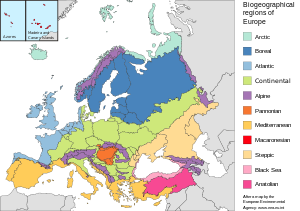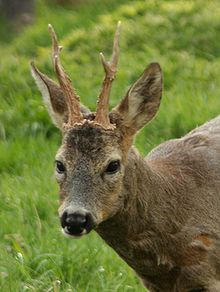User:Kaarel/sandbox/Fauna of Europe
Fauna of Europe are all the animals living in
Origins of European fauna
The formation of the European fauna began in the Mesozoic with the splitting of Laurasian supercontinent and was eventually separated from both North America and Asia in the Eocene. During the early Cenozoic, the continents approached their present configuration, Europe experienced periods of land connection to North America via Greenland, resulting in colonization by North American animals. In these times, higher sea levels sometimes fragmented Europe into island subcontinents. As time passed, sea levels fell, with seas retreating from the plains of western Russia, establishing the modern connection to Asia (Priabonian). Asian animal species then colonized Europe in large numbers.

. The cyclic changes of the Pleistocene between cold and warm periods resulted in antagonistic responses within two different groups of organisms: one expanding during the warm periods and retracting during the cold phases and another with opposed responses (the latter group is composed of so-called arctic and alpine species)[1].
Glaciation during the most recent
See also
Zoogeographic regions
Atlantic Ocean
The north-eastern Atlantic Ocean may be divided into two main biogeographic regions - the
The
The Baltic sea and North Sea are also home to a variety of marine mammals (
Freshwater
Europe contains several important

Arctic tundra
Forests
Eighty to ninety per cent of Europe was once covered by forest. It stretched from the Mediterranean Sea to the
Grasslands
The
Alpine regions
The mountain regions have peculiar fauna relatively little influenced by human activities. The northernmost are the
Mediterranean
Formerly the region was mostly covered with forests and woodlands, but heavy human use has reduced much of the region to the sclerophyll shrublands known as chaparral, matorral, maquis, or garrigue. The loss of native forests had significant impact on biodiversity, with some 90% of the endemic mammalian genera of the Mediterranean becoming extinct after the development of agriculture[9]. Conservation International has designated the Mediterranean basin as one of the world's biodiversity hotspots.
As to the marine fauna, there are strong affinities and relationships between Mediterranean and Atlantic faunas. The deep-water fauna of the Mediterranean ihas no distinctive characteristics and is relatively poor. Both are a result of events after the
Invertebrates

About 100,000 invertebrate species (including insects) are known from Europe[11]. The marine species richness is greatest in the Mediterranean with 600
There are about 1500 species of non-marine molluscs in Europe. The marine fauna is again richest in the Mediterranean region (2000 marine mollusc species)
The
Insects
There are about 300
About 600 species of butterflies and about 8000 species of moths live in Europe. An estimated 18% of all European butterfly species are considered to be vulnerable to or imminently faced with extinction [17].
Fishes
Europe has 344 fresh-water fish species, about 200 of them endemic. Some 277 fish species have been introduced to Europe, and over one-third of Europe’s current fish fauna is composed of introduced species eastern Europe, ..
The common
Amphibians
There live 75 species of
Reptiles

The European
Among the seven species of native
Birds
The list of European
). One bird family, theAbout half of the European birds are
Of the 589 species of birds (excluding seabirds) that breed in the Palearctic, 40% spend the winter elsewhere. Of those species that leave for the winter, 98% travel south to Africa [24].
See also:
Mammals
European mammal fauna consists of 270 species, 78 of them endemic to Europe[18] (15% of them are threatened with extinction and 27% have been identified as declining[25]). There are no endemic mammal orders in the region.
There live about 25 species

Widespread and locally common ungulates are
. Today the largerHuman impact and conservation
Having lived side-by-side with agricultural peoples for millennia, Europe's animals have been profoundly affected by the presence and activities of man. The main causes of biodiversity loss are changes in natural habitats due to intensive agricultural production, construction and extractive industries, over exploitation of habitats and invasions and introductions of alien species.
With the exception of Fennoscandia and northern Russia, few areas of untouched wilderness are currently found in Europe, except for various national parks. There are over 26,000 protected areas in the European Union covering a total area of around 850.000 km2 (more than 20% of total EU territory; see also Natura 2000)[27]. 15% of the
Biodiversity is protected in Europe through the
See also
- Palearctic ecozone
- Fauna of Africa
- Fauna of Australia
External links
- European Commission’s DG Environment [1]
- Fauna Europaea[2]
- The European Register of Marine Species[3]
- European Limnofauna[4]
References
- ^ Z.S.Varga, T.Schmitt, Types of oreal and oreotundral disjunctions in the western Palearctic. Biological Journal of the Linnean Society, 2008, 93, 415–430
- ^ Taberlet, P.; R. Cheddadi 2002. Quaternary Refugia and Persistence of Biodiversity (In Science's Compass; Perspectives). Science, New Series 297:5589:2009-2010
- ^ Sommer, R. S.; N. Benecke. 2005. The recolonization of Europe by brown bears Ursus arctos Linnaeus, 1758 after the Last Glacial Maximum. Mammal Review 35:2:156-164
- ^ M.D.Spalding et al., Marine Ecoregions of the World: A Bioregionalization of Coastal and Shelf Areas, BioScience Vol.57 No.7, 2007
- ^ a b "OSPAR Quality Status Report for the Greater North Sea" (PDF), OSPAR, 2000, retrieved 2007-12-21
- ^ "Factors affecting the distribution Of North Sea fish" (PDF), International council for the Exploration of the Sea ICES, retrieved 2007-12-9
{{citation}}: Check date values in:|accessdate=(help) - ^ E.Leppäloski, Living in a sea of exotics – the Baltic case. (in: Aquatic Invasions in the Black, Caspian, and Mediterranean Seas, ed.H.Dumont et al.)Kluwer Academic Publishers, 2004
- ^ ETI CD-ROM European Limnofauna (Visser and Veldhuijzen van Zanten, 2000)
- ^ Sondaar, P.Y. Insularity and its affect on mammal evolution. In Major Patterns in Vertebrate Evolution (M.K. Hecht, R.C. Goody and B.M.Hecht, eds) New York, Plenum (1977)
- ^ C.C.Emig, P.Geistdoerfer, The Mediterranean deep-sea fauna: historical evolution, bathymetric variations and geographical changes, Carnets de Géologie / Notebooks on Geology, 2004
- ^ Wieringa, K. (ed.) 1995. Environment in the European Union 1995: Report for the Review of the Fifth Environmental Action Programme. European Environment Agency / EUROSTAT
- ^ http://www2.minambiente.it/Sito/Settori_azione/scn/CHM/eng/fauna.htm
- ^ R.Giannuzzi-Savelli et al.; Atlas of the Mediterranean Sea Shells, Edizioni di "La Conchiglia", Roma, 1997
- ^ Platnick, N. I. (2007). The World Spider Catalogue- Version 8.0
- ^ G.A.Polis, The Biology of Scorpions, Stanford University Press (1990)
- ^ a b http://www.faunaeur.org
- ^ Heath, J., Threatened Rhopalocera (Butterflies) in Europe. Council of Europe, Strasbourg, 1981
- ^ a b c Ch.Lévêque, J.-C. Mounolou, Biodiversity, John Wiley & Sons Ltd, 2003
- ^ Y.Reyjol et al., Patterns in species richness and endemism of European freshwater fish, Global Ecology and Biogeography 16 (1) , 65–75
- ^ Kottelat, M. & J. Freyhof, Handbook of European Freshwater Fishes (2007)
- ^ http://www.globalamphibians.org
- ^ Hagemeijer, W.J.M. & Blair, M.J. (1997) The EBCC atlas of European breeding birds, their distribution and abundance. Poyser, London
- ^ B.Bruun, A.Singer. The Hamlyn Guide to Birds of Britain and Europe, Hamlyn 1972
- ^ M.Begon et al.,Ecology - From Individuals to Ecosystems, Wiley-Blackwell (2006) pp.169
- ^ Temple, H.J. and Terry, A. (Compilers). 2007. The Status and Distribution of European Mammals. Luxembourg: Office for Official Publications of the European Communities
- ^ A. J. Mitchell-Jones (Ed.), G. Amori (Ed.), W. Bogdanowicz (Ed.), B. Krystufek (Ed.), P. Reijnders (Ed.), The Atlas of European Mammals. T. & A. D. Poyser Ltd. (1999)
- ^ http://ec.europa.eu/environment/nature/index_en.htm
- ^ European Union. (2001) Presidency Conclusions, Göteborg European Summit 15–16 June 2001.
